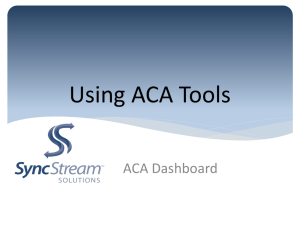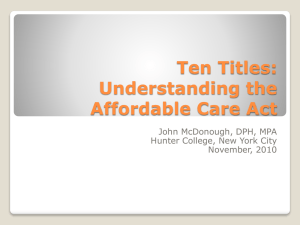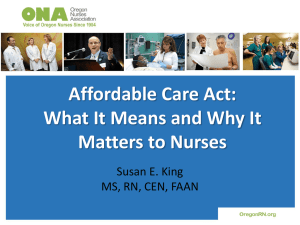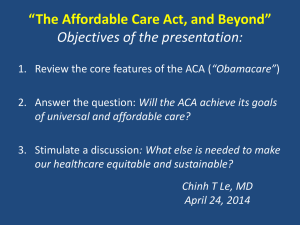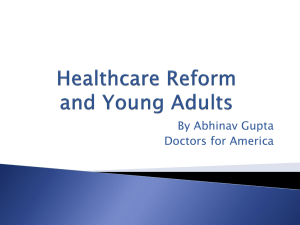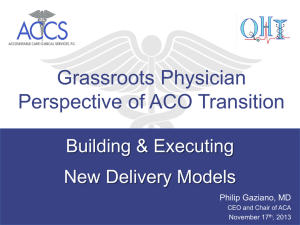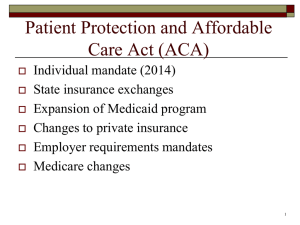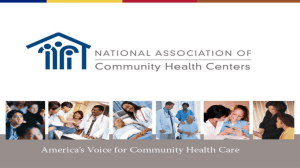Overview of the ACA
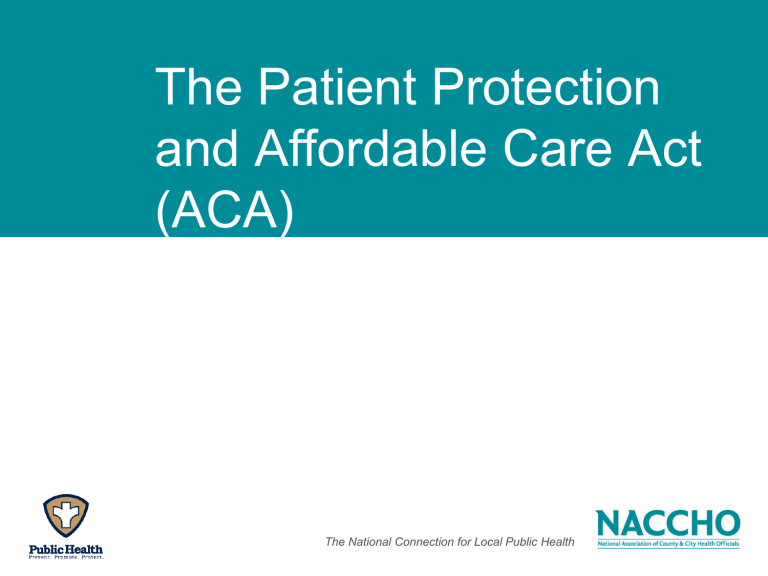
The Patient Protection and Affordable Care Act
(ACA)
The National Connection for Local Public Health
Federal Healthcare Reform “Affordable Care Act” (ACA)
Enacted March 23, 2010
The Bill is the “framework” for healthcare reform
Purpose of reform
• Increase the number of insured
• Reduce healthcare costs
• Focus on quality and better value
• Pay for performance not volume
32 million people are expected to gain coverage
ACA in 2010
• $250 “rebate” for seniors in the Medicare prescription drug
“donut hole” ($2,830 – $6,440/yr)
•Discounts on drugs continue through 2020 to eliminate “donut hole”
• Temporary high risk insurance pools are created for uninsurable
• Employer early retiree assistance is made available until
2014 (reinsurance)
ACA in 2010
Starting September 2010, new private insurance plans address
• Pre-existing conditions in children
• Cancellation of coverage for illness
• Lifetime caps
• Preventive care fully covered (for new group and individual health plans)
• Dependent coverage up to 26 years of age
ACA in 2010
• Tax credits become available for small employers (up to
25 employees and wages under $50,000/yr)
• Consumer assistance via appeals process, website, ombudsmen
• Medicare payments reduced to hospitals, home health, nursing homes, and hospice
• Indoor tanning tax (10%)
• Tax relief and expanded loan repayment plans for primary healthcare providers
ACA in 2011
• Additional funds for Community Health Centers ($11 B over 5 yrs)
• $50 million available FY10-13 for renovation/ construction of school-based health centers
• Physician comparability website for quality
• Out of pocket costs for Medicare preventive services eliminated
• Large pharmaceutical companies begin financial contributions proportional to market share ($2.3 B)
• Health insurance benefit disclosure on W-2 forms
ACA in 2011
• 10% Medicare bonus for primary care physicians and general surgeons (if in shortage areas) through 2015
• Cuts to Medicare Advantage plans in high-cost areas
• Seniors in “donut hole” receive 50% discount on brand names and 7% on generics
ACA in 2012
• Pharmaceutical companies must report when samples given to MDs
• Medicare provides incentives for Accountable Care
Organizations (ACOs) for physicians
• Hospital payment penalties for “readmissions”
• Community Living Assisted Service and Support (CLASS
Act) starts
ACA in 2013
• Medicaid rates for primary care raised to Medicare rates
(for two years)
• Medicare payroll tax increased for “high” earners
(>$200,000 individual/$250,000 family)
• 3.8% tax imposed on unearned income for “high” earners
• 2.3% excise tax on medical devices (not glasses or hearing aids)
• Some Medicaid payment (bundled) pilot programs begin for episodic care and hospitalizations
ACA in 2014
• Health Insurance Exchanges established
• Medicaid income eligibility expands to 133% of the federal poverty level
(100% federal match for newly-eligible enrollees for 3 years)
•$14,404 in annual income for an individual (2009)
•$29,327 in annual income for a family of four (2009)
• Additional funding for Children’s Health Insurance
Program (for 2 years)
ACA in 2014
• Individual insurance mandate and penalties start
•Most individuals required to obtain health insurance or pay a fine
• Family: 1% of income in 2014 up to 2.5% in
2016
• Individual: $95 in 2014 and $265 in 2016
• New catastrophic plans available to adults
<age 30
• Large businesses (50-200) subject to fines if employees qualify for health care subsidies
ACA in 2014
• Federal subsidies for families making up to 400% of the federal poverty line are made available
$43,320 in annual income for an individual
$88,200 in annual income for a family of 4
• Also limits on out-of-pocket expenses ($5,950/ individual) and deductibles ($2,000/individual)
ACA in 2014
• Annual assessments to insurance companies begin to help offset costs of reform
• Insurance companies barred from:
•Denying coverage for pre-existing conditions
•Charging higher fees based on gender
•Imposing annual limits on coverage
ACA in 2015
• Independent Payment Advisory Board created
• Medicare provider payment changes may be made to meet savings targets
• Doctors paid on value rather than volume
• Hospital payments for Safety Net hospitals start to be reduced
ACA in 2017-2018
• “ Cadillac” health plans begin to be taxed at 40% excise tax on policies >$10,200 individual and $27,500 family
• States may permit large employers to participate in insurance exchange plans
ACA in 2020
• ”Donut hole” eliminated (25% co-pay for all drugs)
The Good News
• Expansion of public health & prevention
• More transparency by insurance companies
• More protections for health plan members
• More funding for primary healthcare trainees
• More patient focus and medical home model
Local Opportunities: New Roles and Functions to
Consider
• Expanded role in Medicaid enrollment and in outreach and enrollment for state health insurance exchanges
• Expanded role in case management.
• Maintain and enhance role as health data and information experts for the community.
New Roles and Functions to Consider
• Collaborate with non-profit hospitals to conduct community health needs assessments required by IRS.
• Develop new business models to bill or contract for services.
• Leverage the dollars flowing to FQHC’s by developing a public entity FQHC.
New Partnerships to Consider
• Convene partnerships for population-based prevention, including the engagement of new partners in policy development.
• Pursue relationships with groups forming Accountable
Care Organizations.
• Establish new arrangements with FQHC’s for co-location of services, referrals, and/or purchase of services.
Some Questions to Ask
When more health department clients have insurance cards in hand, what will be the impact on financing and mix of clinical and populationbased services in my community?
Should I plan to transition clinical services to other providers and focus more resources on population-based prevention?
Systemic Challenges That Affect LHDs’ Approaches
• Lack of community support for health system reform.
• Lack of State willingness or capacity to implement
Affordable Care Act.
• Possible influx of new patients to health care systems with inadequate reimbursement or resources (particularly PCPs) to care for them.
Local Health Department Challenges
• Viability as a safety net provider.
• Inability to compete as other entities assume greater roles in prevention and primary care.
• Future funding reductions for public health services erroneously deemed unnecessary by policy makers when expanded health insurance coverage is in place.
Local Challenges
• Realigning resources for altered roles.
• Training the current public health workforce for altered roles.
• Pursuing new opportunities after years of cuts have weakened the public health system.
Other Resources
NACCHO: http://www.naccho.org/advocacy/healthreform/index.cfm
White House: http://www.whitehouse.gov/HealthReform
Department of Health and Human Services: http://www.healthcare.gov/
Kaiser Family Foundation: http://healthreform.kff.org/
Families USA: http://www.familiesusa.org



